After existing for 166 years, through the thick and thins of the American economy, the Hunterdon County National Bank that once was a mainstay on Flemington’s Main Street was taken over by a much bigger national bank in 1983. The HCNB had occupied its beautiful building for nearly that long, about 157 years.
Today the building stands almost empty, waiting for the planned redevelopment of downtown Flemington. Below is a view of how the area may appear—eventually. The bank building is on the right.
3/9/2021, Note: The drawing of the pending development included with the original version of this article was out of date. The drawing above is the current plan. Thanks to Betsy Driver for bringing me up to date.
Not many people are aware of the bank’s interesting history or that of its builder, John C. Hopewell, whom I mentioned briefly in my recent article, “Coming into the Station.” I would like to remedy that.
But to do so I must return to the history of the Fisher-Reading Mansion, because its history is closely related to that of the bank across the street. That is also why I must delve into the history of the two buildings located between the bank building and the Union Hotel, one of which will be demolished, and other will be greatly changed. Their history is also important.
The Fisher-Reading Mansion
When I wrote about the Mansion six years ago, the building was in bad shape, which is why I wrote about it, hoping someone would come along and restore it. Well, the Hunterdon County Chamber of Commerce did just that, and now it is lovely to behold, inside and out. (During the 1980’s, when my husband, Dick Zimmer, served as an Assemblyman and State Senator, he had an office in the Mansion. It was a treat to visit him there.) As for the name I have given it, many Flemington and Hunterdon County residents know it as the Large Mansion, as that family owned and lived in it for a very long time. I chose ‘Fisher-Reading’ to recognize its builder/architect and its first owner.
In that previous article, I wrote that before the building was constructed, its architect and builder, Mahlon Fisher, was hired by the successful merchants, and brothers, John G. and Joseph H. Reading to build a double house for them on Main Street. What resulted was a lovely house at #151-153, located just north of the old train station (which did not yet exist when the house was built).1
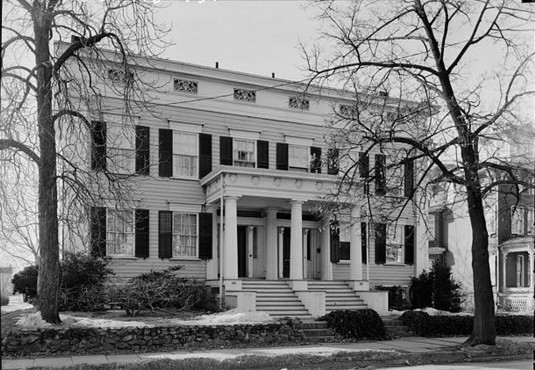
James N. Fisher, Esq.
Two years later, in 1847, Fisher built another Greek Revival house closer to the Courthouse for a third Reading brother, James N. Reading, Esq. (Altogether Fisher built six Greek Revival houses in Flemington, including one for himself.) It was rumored that James N. Reading wanted a house much grander than the one his brothers shared, and that is what he got. Try to imagine Flemington in the 1840s. There were not many houses along the main stretch of Main Street. Even by 1851, when Samuel C. Cornell published his “Map of Hunterdon County,” there were less than 40 structures along Main Street between its intersection with Mine Street and the Presbyterian Church, including the courthouse, several stores, and at least two hotels. And not one could match the Fisher-Reading house for grandeur.

In October 1851, James N. Reading, Esq. announced in The Hunterdon Gazette that he would be temporarily absent in Missouri and that his brother, John G. Reading, would be attending to his business. In James Reading’s notice, he stated that his office was located “in the basement of my residence in Flemington.” I find this surprising since Mahlon Fisher also built a charming structure behind the house that appears to have been intended as an office.
James Reading’s temporary absence turned into a permanent one, in the town of Morris, in Grundy Co., Illinois. In my previous article on this house, I described how James N. Reading ‘made good’ in the Midwest. I did not describe what happened to his Flemington mansion after he left Flemington because a lot more research was involved.
It turns out that the house was such an imposing one that John G. Reading was unable to sell it. Eventually, he just moved in. I must say more about Mr. Reading because not only did he own this house for the rest of his life, but he was also instrumental in the creation of the Hunterdon County Bank.
John Grandin Reading
John G. and his brothers James N., Joseph H., Philip G. and William Reading were sons of Joseph Reading (1778-1853) and Eleanor Newell Grandin (1786-1873), who married in 1804. Joseph Reading was the son of Capt. John Reading, Jr. and Elizabeth Hankinson, and great grandson of Gov. John Reading (see Reading Family Tree. Also, I mentioned John G. Reading several times in my article, “Coming into the Station.”)
Joseph and Eleanor appreciated Eleanor’s family—they gave her maiden name to two of their own sons, John Grandin Reading (1812-1891) and Philip Grandin Reading (1816-1885). Their eldest son James was given the middle name of Newell after his maternal grandmother’s maiden name, and fourth child Joseph was given the middle name of Hankinson, which was his paternal grandmother’s maiden name. (The last child William seems to be missing a middle name.)
By the time the census of 1850 was taken, John and brother Joseph each owned $7500 worth of property, which no doubt included the house they shared on Main Street. They were both rich enough not to need any occupation.
The fact is that the Reading family, going back to the original Reading settler in 1703, was always wealthy. The 1850 census lists Joseph Reading, father of James, John and Joseph, as possessing $19,000 worth of property and also having no occupation. But then, he was 71 years old at the time.
We learn from John G. Reading’s obituary that “From the commencement of his business career until 1882, he was largely interested in the lumber industry.”2 This meant acquiring properties in western Pennsylvania where logging operations were carried on on a large scale. He did so in partnership with architect Mahlon Fisher, as well as with Charles Bartles, who seems to have had a finger in every Flemington pie, and merchant William P. Emery.
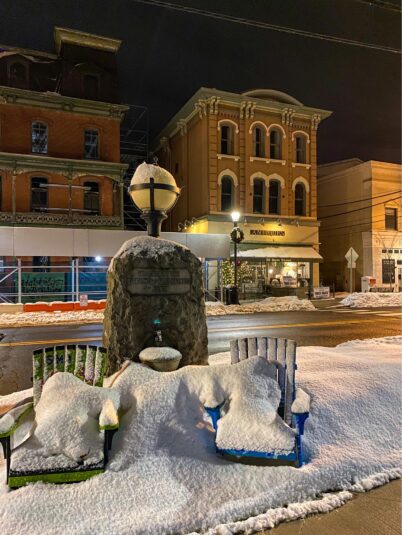
But this comment on Reading’s occupation neglects the fact that from as early as 1834 until 1847, John G. Reading, along with brother Joseph, ran a general store on Main Street in Flemington. (Pictured left, the store as it appears today under a February blanket of snow. Photograph by permission of David Norton, featuring the old watering fountain in front of the court house; one side for people, the street side for horses.)
The brothers were partners, not just in their housing but also in their retail business. They bought their store property, located across the street from the Courthouse, on March 26, 1835 from the estate of Joseph P. Chamberlin for $2,000.3 One year before the purchase, the partners John & Joseph Reading, along with Samuel D. Stryker of Lambertville announced that they were
. . . now opening at the Store Stand lately occupied by Messrs. Miller & Chamberlin, a large and general assortment of NEW GOODS, viz: CLOTHS, Cassimers, Sattinets, &c. &c. GROCERIES of the best kinds. Hardware and Cutlery, Crockery, Earthenware, Stone and Cedarware, Feathers, &c.4
The assortment of goods that Readings & Stryker offered were typical goods to be found in a general store of the 1830s and 1840s. They also offered “fancy and common chairs” and spinning wheels made by one Ezra Smith. The partners identified themselves as “Stryker, Reading & Co.” Stryker had already established a store in Lambertville, and probably moved merchandise from his Lambertville location to the Flemington store as needed. In the spring of 1835, the partners advertised that they also had on hand 10,000 shingles, and by October that number had grown to 30,000. It seems likely that those shingles came from Lambertville.
On maps and in advertisements, it was common to see the brothers designated as J.G. & J. H. Reading. Their partnership was enduring, but additional partners were sort of on-again, off-again. On March 8, 1837, the Hunterdon Gazette published an announcement that the firm of Stryker Reading Co. was dissolved. The notice was signed by S. D. Stryker, Jas. D. Stryker, John G. Reading, Jos. H. Reading and Wm P. Emery. The business was left in the hands of the Readings and William Emery, while the Strykers focused on their business in Lambertville.
The remaining partners carried on, as shown in this notice in the Gazette dated April 5, 1837:
Emery & Readings . . . have just received and are now opening, a fresh and general assortment of Dry Goods, GROCERIES, Liquors, Hardware a large assortment, Crockery, Earthen, Stone, Cedar and Hollow Ware, &c. Also Feathers, Chairs, &c. &c. ––All of which will be shown to those that may have the goodness to call, and which will give them an opportunity of testifying to what they have seen.
This style of advertising is certainly different from that of today. But given the wide range of items offered, it’s easy to see those old general stores as precursors of today’s Walmarts, BJs, etc. Today’s stores have even more goods to offer, but what’s missing today in the large stores is the old-fashioned curtesy toward the customers.
The fact that the Reading store appeared to be going strong in 1837 is impressive, given that that year the country was suffering an economic downturn, commonly referred to as a “Panic.” (See “1837 in Hunterdon County.”) Below is one of the earliest pictures of the Reading-Emery store, on the left, after both Readings and Emery had moved on. Next to it is 80 Main St., slated for demolition, and next to 80 is the bank building. This is probably a c.1900 postcard.5
The partnership of Readings & Emery lasted for only five years. In 1842, they decided to part company, and William P. Emery struck off on his own, opening his own, much bigger store on Main Street just south of Williams Street.6
John and Joseph Reading were apparently not harmed by the loss of a partner, since it was only three years later that Mahlon Fisher built them their handsome house. But in 1848, John G. Reading and brother Joseph also parted company as business partners. John G. Reading was by then focusing his attention on the lumber business, in partnership with his brother-in-law, Wm W. Hedges, in Frenchtown. The firm advertised the following on Feb. 7, 1849 in the Hunterdon Gazette:
500,000 FEET of SEASONED LUMBER on hand and for sale by the subscribers at Frenchtown, consisting of a large lot of heavy inch stuff, yellow Pine Flooring, Siding, Panel from 5-8 to 2 inches thick, Hemlock Siding and Roofing, Shingling, &c. Ceiling Lath, Pine and Hemlock Paling, &c., all of the best qualities the market can produce, and will be sold at a small advance for cash or short credit by Hedges & Reading, Frenchtown.
This partnership dissolved sometime in 1854. Kugler, Lair & Son took over the Frenchtown business, while John G. Reading partnered with Mahlon Fisher and Charles Bartles in a lumber business that probably consisted of Fisher doing the on-site work in Pennsylvania and Reading and Bartles providing the funding. It was extremely successful.
Meanwhile, the old Reading store was left in the hands of Joseph H. Reading, who kept it until his death in 1857. However, he gave up storekeeping himself in 1848, when he leased the store lot to John R. Holcombe, until 1851, when Reading partnered with John L. Jones, and reopened a general store in the old location. (John R. Holcombe relocated.)
Because so many people bought goods on credit, it took businesses a long time to close their books. By March 7, 1849, the Reading brothers were still putting notices in the Gazette like this:
Last Notice. All persons indebted to the late firm of J. G. & J. H. Reading on Bond and Mortgage or note of hand, are requested to PAY UP by the 1st day of April next, and save costs, as the subscribers will have SPECIAL USE for their money at that time. John G. Reading, Jos. H. Reading, Flemington.
Perhaps that special use was for investing in William Reading’s ‘Patent Corn Sheller.’ A notice was published on Nov. 17, 1851 claiming that John G. Reading of Flemington was “the sole proprietor for the manufacture and sale of the above described Shellers for the State of New Jersey,” excepting the county of Warren and a few Hunterdon townships. I have not been able to prove this but would not be surprised to learn that this enterprising William Reading was in fact the youngest brother of the Reading family, born in 1822 and married to Sarah Matilda Capner, daughter of Hugh R. Capner & Matilda Anderson.
John G. Reading prospered from his retail business and from his lumbering business. But he did not sit around all day enjoying his wealth. He clearly had standing in his community; in 1838 he was nominated to run as a Whig for the NJ Assembly. He was also involved in supporting the Flemington Fire Co., being tasked in 1839 with the job of getting estimates for construction of a fire house.
Reading was present at a meeting of the citizens of Flemington in 1844 to consider applying to the NJ Legislature to incorporate the Village of Flemington, and was named, along with Mahlon Fisher and George Forker, to a committee to solicit subscriptions for that purpose. He served as Clerk of Raritan Township in the years 1852-53, and in 1853 became a trustee of the Flemington Presbyterian Church, up until 1870.
During the years that John G. and Joseph H. Reading were running their store, their brother James was practicing law, as described in my previous article on the mansion house. Like his brother John, James N. Reading was very prosperous. As such they were strong supporters of the Whig party in Hunterdon, and strongly opposed to the economic policies of Andrew Jackson.
1854, A Significant Year
Creation of a Political Party
Ever since the election of Andrew Jackson in 1828, Hunterdon County was a stronghold for Democrats or “Democratic Republicans,” as they were sometimes called.
However, there were a number of people in Hunterdon who objected to Jackson’s policies, especially his hostility toward the national bank. In the 1830s, they were called “The Opposition”, and eventually “Whigs”. The campaign of 1840 that resulted in the election of Whig candidate William Henry Harrison really invigorated the local Whig party. By 1843, the Whigs of Hunterdon had gained a strong advocate in the person of Henry Clay Buffington (1816-1900), owner and editor of the Hunterdon Gazette. With a name like that, it is not surprising that he would support the party of Henry Clay. Other active members included George W. Risler, Samuel Hill, Hugh Capner, Peter I. Clark, James N. Reading, John G. Reading, George A. Allen and William P. Emery, and many others.
Following the presidential election of 1852, in which the Whig candidate, Gen. Winfield Scott, lost to the Democrat, Franklin Pierce, the Whig party basically collapsed—at least on a national level. There were still Whigs running for local elections in 1853, but they did not do very well. Democrats in Raritan Township prevailed, winning such positions as Assessor, Collector, School Superintendent, Chosen Freeholder, and Constable.
As the party was faded, so did the number of Buffington’s subscribers. In March 1854, Buffington gave up. He sold the Gazette to one Willard Nichols and moved west to the home of his old friend, James N. Reading, in the town of Morris in Grundy Co., Illinois.
Filling the gap left by the old Whig party was a new political party, founded in 1854, based on ending the expansion of slavery into new states in the Midwest. It took some time for the Republican party to spread through the whole country. It certainly was not a presence in Hunterdon County after Nichols took over the Gazette. Reading the issue of April 12, 1854, one would think the Whigs were stronger than ever. In September 1854, Nichols published announcements for the Whig Convention to be held in Somerville in October. Nichols not only attended the Raritan Township meeting to choose delegates to the convention; he was appointed secretary for the meeting, which was chaired by Peter I. Clark, Esq.
Nichols is something of a mystery. He seems to come out of nowhere. He was born somewhere in New York in 1814, so he was already 40 years old when he took over the Gazette. The first issue under his name appeared on March 29th. At some point between this date and Nov. 28, 1855, Nichols moved into the Fisher-Reading mansion. (The advertisement of Nov. 28, 1855 in the Gazette in which John G. Reading offered the mansion for sale, included the phrase: “now in the tenure of Willard Nichols.”) Since John G. Reading was an active Whig, it is not surprising that he would choose as a tenant for the mansion, the Whig-leaning editor of the Gazette.
Hunterdon’s New Bank
1854 certainly was an eventful year. Was it a coincidence or a direct consequence that the same year that the Republican Party was born, a new bank was organized in Flemington?
The consequences were 1) the expansion of commerce in Hunterdon County in the 1850s, and the problems caused by Jackson’s banking policies. The old national bank was the brainchild of Alexander Hamilton. By the time Jackson was president in 1828, the national bank was run by Nicholas Biddle, a man Andrew Jackson loved to hate. Jackson was determined to close the Second Bank of the U.S., and he succeeded in 1834 by pulling out the Federal funds and depositing them in private state banks. These banks were chartered by the states and had existed since 1781. After Jackson pulled out of the national bank, the state-chartered banks came to dominate the economy. The years after 1834 came to be known as the Free-Banking Era, or the era of Wild-Cat Banking, since many state banks were not very tightly regulated, and commonly failed after only about five years. In 1848, New Jersey passed the Free Banking Act, which attempted to regulate the chartering of state banks.
New banks were proposed to the legislature after this, but it was not until April 5, 1854 that the Hunterdon County Democrat was able to publish this announcement:
“A NEW BANK. A number of gentlemen in this place and vicinity are about organizing a new Bank under the General Banking Law, with a capital of $100,000, to be located at Flemington. The stockholders have had a meeting and elected the Hon. Isaac G. Farlee as President, Wm. Emery, our County Clerk, Cashier, and a Board of Directors, comprising some of the best businessmen in the County. Under the direction of such men, the public have a guaranty that the business of the Bank will be confined to a proper and legitimate channel; and therefore, cannot fail to become a general benefit, as well as a source of profit to the Stockholders. . . . The Hunterdon County Bank will be ready for business about the thirtieth of this month.”7
On April 21, 1854, Cornelius Williamson purchased Share No. 1 of the Hunterdon County Bank stock. The next day, stock was sold to William Emery, John R. Emery, George A. Allen, and Isaac G. Farlee. The certificates were signed by Isaac G. Farlee, president, and William Emery, cashier.8
On January 12, 1855, the bank’s president, Isaac G. Farlee, died. He was succeeded by George A. Allen, Esq. (1822-1878), who served as president until 1858. Allen had come to Flemington from Connecticut and taken up the study of law in the office of none other than James N. Reading. In 1850, he married Mary Bonnell (1822-1904), daughter of Charles Bonnell & Margaret Anderson, and cousin of the prominent merchant and in 1853-1855, NJ State Senator, Alexander V. Bonnell.
The Peripatetic Bank
On Dec. 20, 1854, the Hunterdon County Bank published a notice in the Hunterdon Gazette for its Annual Meeting (obviously its first) to be held “at their Banking House in Flemington.” But where was their “Banking House”?
The bank did not yet have the assets to buy a lot on Main Street and put up a building. I cannot say for sure where the bank was located when it was formed, but for a time, it was located in a house belonging to Hugh Capner, according to a notice in the Hunterdon Gazette dated July 15, 1857, by one William J. Owens of Trenton stating that he “has taken a room in Mr. Hugh Capner’s House, recently occupied by the Hunterdon County Bank, in Flemington.”
The problem is that Mr. Capner owned so much real estate, it is not possible to say for sure which of his many houses the bank resided in. But apparently, by July 1857 it had moved out, and its new location was the basement of the Reading Mansion. By that time, John G. Reading had taken possession of the Mansion from his brother James, and as one of the bank directors it was natural for him to make his brother’s old office available to the bank.
According to a bank history written in 1939, the bank offices were located “in two small basement rooms that had been used by Mr. Reading as his law offices. Entrance was gained to these quarters thru the areaway under the spacious front porch.”
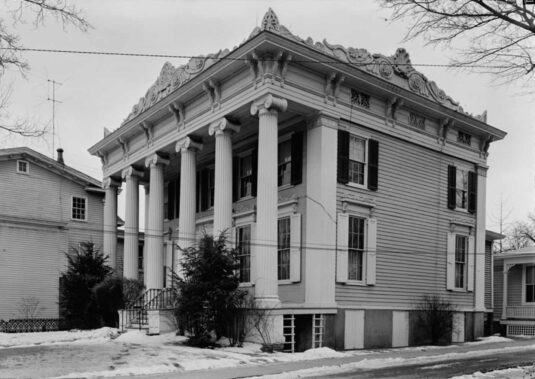
Fortunately, Mahlon Fisher had not yet moved to Pennsylvania. He was probably available to install a vault for the bank to use. Being the inventive person he was, he designed “a unique locking device.” It was found on the parlor floor under a trap door hiding under a rug in front of the hearth.
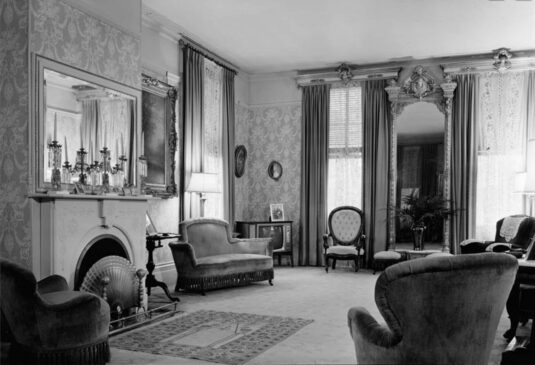
With the door open, one found an iron bar that dropped down into the basement and unlocked the vault.
George A. Allen’s Residence
According to The Story of The Hunterdon County National Bank of Flemington,9 at some point, the bank moved again, this time to the store building owned by its then president, George A. Allen, Esq. Allen was the founder of the Hunterdon Republican newspaper in 1856. Like Hugh Capner, he owned a great deal of property, but the most likely location of the storehouse is shown on the Beers Atlas of 1873. It was just north of the lot owned by Alexander Wurts and just south of the County Hotel, owned by William H. Force.10
The Bank Charter
The bank was created and was selling stock in 1854. But in 1855, a decision was made to apply to the State Legislature for a “special charter” that would relieve it of some of the regulations for NJ state banks.
The question of issuing a charter was being debated in the State Senate on February 7, 1855 when the bill was taken up on its third reading. As one might expect, Hunterdon County’s representative, Alexander V. Bonnell, was strongly in favor of it. The speech he gave in its support was published in full in The Hunterdon Gazette. Bonnell stated:
The only benefit I expect to receive from the chartering of this institution is that which I will derive in common with all the businessmen of Hunterdon county I represent, feeling the necessity for a sound and well conducted banking institution . . . To secure so important an interest, a departure from the General Banking law is manifestly necessary. . . . The county of Hunterdon has enjoyed the honor of having had within her limits three of the legitimate offsprings of the General law. The first two were ostensibly located in Hunterdon, but really in Wall street, and were managed by Wall street brokers, who commit their depredations upon the business community, and then come to New Jersey to have them legalized. The third was organized by our own citizens for the purpose of doing a fair bona fide banking business. The bill now before the Senate, gives this third institution a special charter. The eight months that this bank has been in operation has proved its entire inability to meet the wants of our people, and is it the fault of those who control it? No, it is the fault of the law. . . .
Bonnell was referring to the General Banking Law, which Bonnell felt was deeply flawed in its requirements of banks and was the cause of previous bank failures. Hence the legislation for a special charter. But there was some opposition. It came from Jonathan Pickel, a powerful Democrat and former member of the House from Alexandria Township. Perhaps Pickel just wanted to give the Hunterdon Whigs who supported the new bank a hard time. He tried to persuade his allies in the Senate to require that all stockholders must approve of the change. This argument was ignored, and the Senate passed the bill for a special charter on April 5, 1855, by a margin of 12 to 5.
On July 18th, the Gazette published this notice:
We the Undersigned, Commissioners appointed by the act of the Legislature of New Jersey at its last session, entitled “AN ACT TO INCORPORATE THE HUNTERDON COUNTY BANK,” do hereby give notice, that on Wednesday, the 8th day of August next, we shall open a subscription at the Banking House in Flemington, of said “Hunterdon County Bank,” to raise the sum of One Hundred Thousand dollars, in shares of $25 each. . . . [signed] George A. Allen, Andrew G. M. Prevost, Wm. R. Moore, Hiram Deats, Samuel C. Eckel, Bennet VanSyckle, John Runk, John S. Williamson, Alexander Wurts, Charles Bartles, [and, our friend] John G. Reading.
Back to the Mansion
A Mansion for Sale, 1855-56
After it became clear that James N. Reading would not be returning to Flemington, except to visit, responsibility for his extravagant mansion fell to brother John.
Either John was quite happy in his own house or he felt an obligation to remain close to his younger brother Joseph, who suffered from ill health. Whatever the case, John G. Reading put the mansion house up for sale, as advertised on Nov. 28, 1855 in The Hunterdon Republican:
RARE CHANCE ! DESIRABLE PROPERTY IN FLEMINGTON FOR SALE! The subscriber will sell at Public Sale, on Saturday, December 22, on the premises, at 1 o’clock P. M., the HOUSE and LOT now in the tenure of Willard Nichols, situate on Main street, in Flemington, a few rods south of the Court House. The lot is 60 feet front by over 300 feet deep, and fronts on two streets. The improvements upon it are a commodious two-and-a-half story Dwelling House, with 3 rooms on the first, and five rooms on the second floor, with an excellent cellar underneath the whole. There is also attached a building seventeen by twenty, suitable for any kind of an office, bookstore or millinery establishment. There is a new cistern at the door of the Kitchen. There is also on the premises, a wood house, barn, stabling, cow-house and wagonhouse. In short, it is one of the most desirable properties in Flemington. A further description is unnecessary, as those wishing to purchase will examine for themselves. For further particulars, or a view of the premises, call on the undersigned. JOHN G. READING.
Note that the property was “a few rods south of the Court House,” which is where the Mansion House stands. Also note, as mentioned above, that it was “now in the tenure of Willard Nichols.” Although Nichols was then editor of The Hunterdon Gazette, it is not likely that he was running the Gazette from the Reading Mansion. More likely the Gazette offices were located on a half-acre across the street that Buffington had purchased from John C. Hopewell in 1848, and which Buffington sold to the Reading brothers and Hopewell in 1856.11
Perhaps most curious of all, the advertisement said nothing about the bank being in the residence. Because sources of information are vague about when the bank was located in the Capner house, the Allen store and the Reading Mansion, I suspect that the bank may have moved into the Reading Mansion after spending time at the Allen store.
In any case, it seems that the mansion house was just a bit overwhelming for most shoppers, because despite the glowing description, the house went unsold.
James N. Reading visits Flemington
A year later, in 1856, James N. Reading returned to Flemington from his new home in Morris, Illinois for a visit, as reported in the Gazette of Nov. 26, 1856:
COL. JAS. N. READING. This gentleman, who, with his lady, has been on a visit of several weeks to his old home, left on Tuesday morning for Morris, in Illinois, his present residence. The re-union with his old friends was as usual, cordial in the extreme. Absence does not at all abate the kindly feeling cherished for him by almost every person in Flemington. Mr. JOSEPH H. READING, whose precarious health has been for years a source of deep regret to his numerous friends, accompanies the Colonel to Morris, in hope that a change of scene and climate may prove beneficial to him. We most sincerely and fervently hope he may not be disappointed; and but echo the wishes of everyone, that he may be soon permitted to return with the glow of restored health mantling his cheek and warming his generous heart.
During the time that James N. Reading was in Flemington, John G. Reading and wife Sarah sold their share of the double house at 151-53 Main St. to John’s brother Joseph for $1. The deed, dated November 24, 1856, described how the lot line went through the center of the house, “leaving the south part of said dwelling house to said Joseph H. Reading.”12
Then on Dec. 23, 1856, James N. & wife Sarah C. Reading sold the mansion house to John G. Reading of Flemington for $6,000. The deed described the property as a lot of 0.92 acres on Main Street, bordering Asa Jones, the corner lot of William P. Emery (i.e., the corner of Main and Mine Streets), Charles Bartles, Bartles’ alleyway, and lots belonging to John Bush, Robert Carrell, & Charles Thatcher.13 This price was high for the time. It might have been somewhat lower if John Reading had waited a year, because in September of 1857, the country experienced one of its periodical economic downturns.
But John G. Reading could afford this fancy house. During the years after the Civil War, the Hunterdon Republican published the names of taxpayers. Congress had established an income tax to cover the cost of the war, and the newspaper was probably carried away by the novelty of it. During three of the five years that taxes were published, John G. Reading was the richest man in Flemington, or at least the one paying the most income tax. (The lawyer and bank president, George A. Allen, paid the most in 1866, and Rev. John L. Janeway paid the most in 1869, with John G. Reading coming in second.)14
New Directors for the Hunterdon Bank
In January 1858, The Hunterdon Republican published the results of the recent meeting of the Stockholders of the Hunterdon County Bank in which new Directors were elected. They were George A. Allen, Charles Bartles, John G. Reading, Thosmas B. Carr, Charles Tomlinson, Nathan Huffman, Andrew Van Syckel, Runkle Rea, Peter E. Voorhees, and John L. Jones. This was followed by an election of officers, although it is unclear who voted, stockholder or the new Directors. George A. Allen was elected President, but he immediately resigned and at the same time disposed of his holdings. This may have had something to do with Allen’s new avocation—ownership of the The Hunterdon Republican. The bank directors proceeded to elect Charles Bartles as president.
The next week, on January 13, 1858, the Republican had to amend its story on the bank meeting.
“Last week in publishing the names of the newly elected Directors of the Hunterdon County Bank we omitted three names. The following is correct: John C. Hopewell, John S. Williamson, Miller Kline, Charles Bartles, John G. Reading, Thomas B. Carr, Charles Tomlinson, Nathan Hoffman, Andrew Van Syckel, Runkle Rea, Peter E. Voorhees and John L. Jones.”
I have highlighted Hopewell’s name because he was the one who built a permanent home for the Hunterdon Bank, and will be featured in my next article. The later ownership of the Readings’ old store will also get some attention.
Footnotes:
- The railroad station on Main St. was first erected in 1854. The station house that exists today was built in the mid to late 19th century. ↩
- Obituary published in the Hunterdon Republican, Feb. 4, 1891. ↩
- H.C. Deed Book 59 p.534. ↩
- Hunterdon Gazette, March 5, 1834. The previous storekeepers were John S. Chamberlin, son of the previous landowner, Joseph P. Chamberlin, and Andrew Miller, Joseph Chamberlin’s son-in-law. ↩
- Here I must express my thanks to architect Chris Pickell for generously sharing many photographs from his collection and identifying where they were located. Also, many photographs in this article and future articles, excepting the HABS photographs, have no provenance. They came mostly from the collections of Raymond Storey and Richard Higgins, who shared their photographs on Facebook. I should also mention the website, West Jersey History Project, for its impressive collection of images. ↩
- Hunterdon Gazette, March 9, 1842 and August 10, 1842. ↩
- This item was republished in the Bank booklet, Serving Hunterdon One Hundred Years, 1854-1954; A Picture Story of our County and Hunterdon’s First Bank. Published for the Hunterdon County National Bank of Flemington, N.J., 1955, by the Democrat Press of Flemington, NJ with the cooperation of the Village Craftsmen, Rosemont, N.J. ↩
- Note that original bank minutes were not preserved, and contemporary sources never published names of the first Board of Directors. The list of original shareholders was filed at the County Clerk’s Office, consisting of 82 men and one woman. Of course, I’d like to know who that woman was, but will have to wait until I can visit the office. Also note that William Emery was probably not the merchant William P. Emery who partnered with the Reading brothers. ↩
- Author unknown, reprinted from the Hunterdon County Democrat, 1939. ↩
- Note that the Beers Atlas does not identify the bank on this lot because by 1873 it had moved again. ↩
- H.C. Deeds Book 91 p.147, Book 113 p. 355. ↩
- H.C. Deed Book 114 p.693. ↩
- H.C. Deed Book 117 p.85; unfortunately, there was no recital. ↩
- Tax payments were published in the Hunterdon Republican for the years 1865-1869. Oddly enough, John G. Reading and Charles Bartles, two of the richest men in town, were missing from the 1866 report. ↩

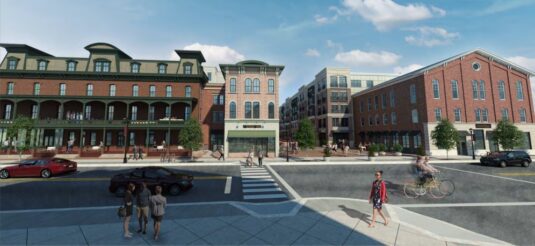
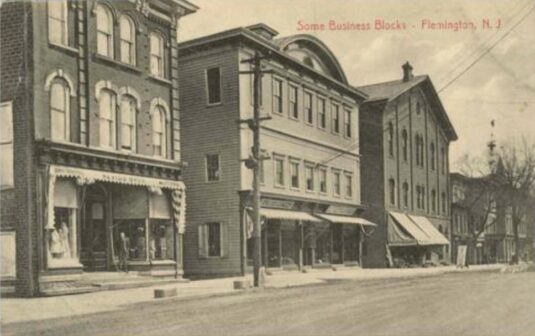
Thomas Reading
May 8, 2021 @ 11:58 am
Thank you for teaching me.